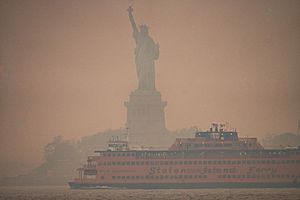2023 Canadian wildfires facts for kids
Quick facts for kids Canadian wildfires of 2023 |
|
|---|---|
|
|
| Location | Canada (all 13 provinces and territories) |
| Statistics | |
| Total fires | 5,765 (as of August 17, 2023) |
| Total area | 13.749 million ha (33.97 million acres) (as of August 17, 2023) |
| Date(s) | March 1, 2023 |
| Deaths | 5 |
| Evacuated | 155,856 people (as of July 7, 2023) |
Starting in March 2023, Canada experienced a huge number of wildfires. These fires became much stronger in June. This wildfire season has been the worst ever recorded in Canadian and North American history.
All 13 provinces and territories in Canada were affected. Big fires burned in places like Alberta, British Columbia, Nova Scotia, and Quebec. By June 25, experts said this was the worst fire season Canada had ever seen.
As of August 17, 2023, over 5,700 fires had burned more than 13.7 million hectares. This is about four percent of Canada's total forest area. It is also five times more than the usual amount of land burned by that time of year. Many countries sent help to Canada to fight these fires.
Smoke from the wildfires caused bad air quality and forced people to leave their homes in Canada and the United States. By late June, the smoke had even traveled across the Atlantic Ocean to Europe.
Contents
Why Did the Fires Happen?
Wildfires in Canada usually start in May. Since the 1970s, the number of fires has gone down. However, the total area burned by fires has actually gone up. The average fire season has also become about two weeks longer.
How Climate Change Affects Fires
Climate change makes the weather warmer and drier. This means plants and trees become very dry and catch fire more easily. A strong wind in May made the fires even worse.
Canada's Minister of Public Safety, Bill Blair, said that these conditions were "unprecedented" for so early in the season. He warned that extreme weather events like these might happen more often because of climate change.
Forest Management and Fires
How forests are managed also plays a role. Canada has mostly focused on stopping fires completely. This has led to a lot of dry plants building up on the forest floor. Normally, controlled burns (small, planned fires) help clear out this dry material. These burns make it harder for bigger, more dangerous fires to start.
It is often hard to get permission for controlled burns. This is especially true for Indigenous groups. They have historically used controlled burns but are often hit hardest by wildfires. Canada also does not have one national firefighting service. Local firefighting teams are often short on money and resources.
What Starts Wildfires?
About half of all wildfires in Canada are started by lightning. Because of climate change, lightning strikes are happening more often. Fires started by lightning burn about 85% of the land. These fires often happen in remote areas.
The other half of wildfires are started by people. This often happens by accident. Examples include cigarette butts, campfires not put out properly, or sparks from trains. While some people on social media have spread false claims about arson (fires set on purpose), it is generally not a main cause of wildfires in Canada.
Wildfires also release a lot of smoke and gases into the air. This pollution can affect people's health for a long time. In late June, Canada broke its record for yearly carbon emissions because of the wildfire smoke.
Impact in Canada
In May, oil companies in Alberta, British Columbia, and Saskatchewan reduced how much oil they produced. They did this to be safe because of the fires. This then caused the price of oil to go up.
International Effects
United States


In May, the Minnesota Pollution Control Agency warned people about bad air quality. This was due to smoke from fires in Alberta and Saskatchewan. Smoke from Alberta also caused air quality alerts in many other states like Colorado and Montana.
On June 2, smoke from Nova Scotia fires reached Washington, D.C., Maryland, Pennsylvania, and Virginia. On June 5–6, smoke from Quebec fires moved into the Northeastern United States. This caused air quality alerts for most of New York, Connecticut, and nearby states. By June 6, the smoke was so bad that one expert said it was the third-worst in the U.S. since 2006.
By the night of June 6, New York City had the worst air pollution of any major city in the world. The next morning, it was second worst, after Delhi. This was New York City's worst air quality since the 1960s.
By June 7, about 128 million Americans were under air quality alerts. In some areas, like New York City, the air quality index went above 400. This is a very dangerous level. New York City officials gave out one million N95 masks to help people.
Many flights to and from New York City, New Jersey, and Washington, D.C., were delayed or canceled. The Federal Aviation Administration even stopped all flights to LaGuardia Airport because of poor visibility.
Schools in New York, New Jersey, and Connecticut announced closures. Some schools switched to online learning. Sports games, including Major League Baseball and National Women's Soccer League games, were postponed. Even some Broadway shows were canceled due to the bad air.
On June 8, air quality was worst around Pennsylvania, Washington, D.C., and Trenton, New Jersey. Philadelphia had its worst air quality since 1999. New York City's air quality was so bad that Governor Kathy Hochul called it an "emergency crisis." Flights continued to be delayed.
By June 11, air quality had improved, but alerts were still active in some cities. On June 14, Minnesota had another air quality alert. The air quality in Minneapolis reached 256.
On June 27, the smoke spread over the Midwest. Chicago had the worst air quality in the world, reaching 228 AQI. Michigan and Pennsylvania also had air quality alerts. About 80 million people in the U.S. were under air quality warnings.
Europe
The wildfire smoke also traveled to Europe. In late May, it was mainly over Scandinavia. By June 8, Iceland and Greenland were affected. Forecasts suggested Norway would also see smoke. As of June 9, the smoke in Europe was not thick enough to harm people's health.
On June 25, the smoke reached the Azores. By June 26, it reached Western Europe, including France, Portugal, Spain, and the United Kingdom. The smoke was higher in the sky there, so it did not affect air quality as much as in the United States. However, it was predicted to cause more colorful sunrises and sunsets.
See also
 In Spanish: Incendios forestales en Canadá de 2023 para niños
In Spanish: Incendios forestales en Canadá de 2023 para niños
- List of disasters in Canada
- List of fires in Canada








